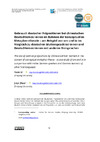Identificador persistente para citar o vincular este elemento:
https://accedacris.ulpgc.es/jspui/handle/10553/132202
| Campo DC | Valor | idioma |
|---|---|---|
| dc.contributor.author | Li, Yuan | en_US |
| dc.contributor.author | Zhao, Jieyi | en_US |
| dc.contributor.editor | Universidad de Las Palmas de Gran Canaria, null | - |
| dc.date.accessioned | 2024-07-18T16:27:35Z | - |
| dc.date.available | 2024-07-18T16:27:35Z | - |
| dc.date.issued | 2024 | en_US |
| dc.identifier.issn | 2340-8561 | en_US |
| dc.identifier.uri | https://accedacris.ulpgc.es/handle/10553/132202 | - |
| dc.description.abstract | In dieser Arbeit wird der Gebrauch der deutschen Präpositionen umund inbei chinesischen Deutschlerner/-innen im Rahmen der konzeptuellen Metapherntheorie anhand des CDLK-Korpus und Falko-Korpus analysiert. DiePräposition in, so die Untersuchung, weisteine deutlich höhere Fehlerhäufigkeit als die Präposition umauf, was letztlich auf Unterschiede in den kulturellen und konzeptuellen Systemen in Deutschland und China zurückzuführen ist. Darüber hinaus verwenden chinesische Deutschlerner/-innen Präpositionen häufiger in ihren räumlichen und zeitlichen Bedeutungen und seltener in ihren metaphorischen Bedeutungen. Außerdem gibt es keine eindeutigeKorrelation zwischen der Lerndauer der chinesischen Deutschlerner/-innen und der Fehlerzahl. Konsequenzen sollen entsprechend für die Verbesserung der Lehre gezogen werden. | en_US |
| dc.description.abstract | In this article, Chinese German learners’ use of the prepositions umand inis analyzed in the context of conceptual metaphor theory using the CDLK corpus and Falko corpus. The study reveals that the error rate of the preposition inis significantly higher than that of the preposition um, which is ultimately due to the differences in cultural and conceptual systems between Germany and China. Chinese German learners use the spatial and temporal meanings of the prepositions more frequently,while they use the metaphorical meanings less frequently. Furthermore, there is no clearcorrelation between the learning time of Chinese German learners and the number of errors. The conclusions of this study could provide insights for improvements in teaching. | en_US |
| dc.language | deu | en_US |
| dc.relation.ispartof | LFE. Revista de Lenguas para Fines Específicos | en_US |
| dc.source | LFE. Lenguas para Fines Específicos [ISSN 1133-1137, 2340-8561], v. 30, p. 62-83 , (Junio 2024) | en_US |
| dc.subject.other | Deutsche Präpositionen | en_US |
| dc.subject.other | Chinesische Deutschlerner/-innen | en_US |
| dc.subject.other | Konzeptuelle Metapherntheorie | en_US |
| dc.subject.other | Metaphorische Bedeutung | en_US |
| dc.subject.other | German prepositions | en_US |
| dc.subject.other | Chinese German learners | en_US |
| dc.subject.other | Conceptual metaphor theory | en_US |
| dc.subject.other | Metaphorical meanings | en_US |
| dc.title | Gebrauch deutscher Präpositionen bei chinesischen Deutschlerner/-innen im Rahmen der konzeptuellen Metapherntheorie – am Beispiel von um und in im Vergleich zu deutschen Muttersprachler/-innen und Deutschlerner/-innen mit anderen Erstsprachen | en_US |
| dc.title.alternative | The Use of German prepositions by Chinese German learners in the context of conceptual metaphor theory-a case study of um and in in comparison with native German speakers and German learners of other first languages | en_US |
| dc.type | info:eu-repo/semantics/article | en_US |
| dc.type | Article | en_US |
| dc.identifier.doi | 10.20420/rlfe/2024.699 | en_US |
| dc.description.lastpage | 83 | en_US |
| dc.identifier.issue | 30 | - |
| dc.description.firstpage | 62 | en_US |
| dc.relation.volume | 30 | en_US |
| dc.investigacion | Artes y Humanidades | en_US |
| dc.type2 | Artículo | en_US |
| dc.description.numberofpages | 22 | en_US |
| dc.utils.revision | Sí | en_US |
| dc.contributor.wosstandard | Universidad de Las Palmas de Gran Canaria, null | - |
| dc.contributor.wosstandard | Universidad de Las Palmas de Gran Canaria, null | - |
| dc.contributor.wosstandard | Universidad de Las Palmas de Gran Canaria, null | - |
| dc.contributor.wosstandard | Universidad de Las Palmas de Gran Canaria, null | - |
| dc.contributor.wosstandard | Universidad de Las Palmas de Gran Canaria, null | - |
| dc.contributor.wosstandard | Universidad de Las Palmas de Gran Canaria, null | - |
| dc.contributor.wosstandard | Universidad de Las Palmas de Gran Canaria, null | - |
| dc.contributor.wosstandard | Universidad de Las Palmas de Gran Canaria, null | - |
| dc.contributor.wosstandard | Universidad de Las Palmas de Gran Canaria, null | - |
| dc.contributor.wosstandard | Universidad de Las Palmas de Gran Canaria, null | - |
| dc.date.coverdate | Junio 2024 | en_US |
| dc.identifier.ulpgc | No | en_US |
| dc.contributor.buulpgc | BU-HUM | en_US |
| dc.description.sjr | nan | |
| dc.description.sjrq | - | |
| dc.description.esci | ESCI | |
| dc.description.fecytq | Q3 | |
| dc.description.fecytpuntuacion | 25,69 | |
| dc.description.dialnetimpact | 0,0 | |
| dc.description.dialnetq | Q1 | |
| dc.description.miaricds | 9,9 | |
| dc.description.erihplus | ERIH PLUS | |
| item.grantfulltext | open | - |
| item.fulltext | Con texto completo | - |
| Colección: | Artículos | |
Visitas
89
actualizado el 01-mar-2025
Descargas
36
actualizado el 01-mar-2025
Google ScholarTM
Verifica
Altmetric
Comparte
Exporta metadatos
Los elementos en ULPGC accedaCRIS están protegidos por derechos de autor con todos los derechos reservados, a menos que se indique lo contrario.
